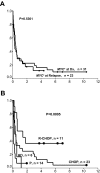Lymphomas with concurrent BCL2 and MYC translocations: the critical factors associated with survival
- PMID: 19597184
- PMCID: PMC2745846
- DOI: 10.1182/blood-2009-03-212191
Lymphomas with concurrent BCL2 and MYC translocations: the critical factors associated with survival
Abstract
BCL2 and MYC are oncogenes commonly deregulated in lymphomas. Concurrent BCL2 and MYC translocations (BCL2(+)/MYC(+)) were identified in 54 samples by karyotype and/or fluorescence in situ hybridization with the aim of correlating clinical and cytogenetic characteristics to overall survival. BCL2(+)/MYC(+) lymphomas were diagnosed as B-cell lymphoma unclassifiable (BCLU; n = 36) with features intermediate between Burkitt lymphoma and diffuse large B-cell lymphoma (DLBCL); DLBCL (n = 17), or follicular lymphoma (n = 1). Despite the presence of a t(14;18), 5 cases were BCL2 protein-negative. Nonimmunoglobulin gene/MYC (non-IG/MYC) translocations occurred in 24 of 54 cases (44%) and were highly associated with DLBCL morphology (P < .001). Over a median follow-up of 5.3 years, 6 patients remained in remission and 32 died within 6 months of the MYC(+) rearrangement, irrespective of whether MYC(+) occurred at diagnosis (31 of 54) or transformation (23 of 54; P = .53). A non-IG/MYC translocation partner, absent BCL2 protein expression and treatment with rituximab-based chemotherapy, were associated with a more favorable outcome, but a low International Prognostic Index score and DLBCL morphology were independent predictors of overall survival. A comprehensive cytogenetic analysis of BCL2 and MYC status on all aggressive lymphomas may identify a group of high-risk patients who may benefit from chemotherapeutic regimens that include rituximab and/or BCL2-targeted therapy.
Figures



References
-
- Tsujimoto Y, Cossman J, Jaffe E, Croce CM. Involvement of the bcl-2 gene in human follicular lymphoma. Science. 1985;228:1440–1443. - PubMed
-
- Vaux DL, Cory S, Adams JM. Bcl-2 gene promotes haemopoietic cell survival and cooperates with c-myc to immortalize pre-B cells. Nature. 1988;335:440–442. - PubMed
-
- McDonnell TJ, Deane N, Platt FM, et al. bcl-2-immunoglobulin transgenic mice demonstrate extended B cell survival and follicular lymphoproliferation. Cell. 1989;57:79–88. - PubMed
-
- Weiss LM, Warnke RA, Sklar J, Cleary ML. Molecular analysis of the t(14;18) chromosomal translocation in malignant lymphomas. N Engl J Med. 1987;317:1185–1189. - PubMed
Publication types
MeSH terms
Substances
Grants and funding
LinkOut - more resources
Full Text Sources
Other Literature Sources
Molecular Biology Databases
Research Materials

